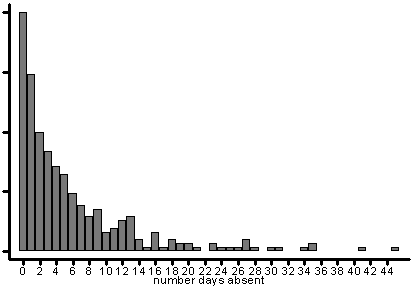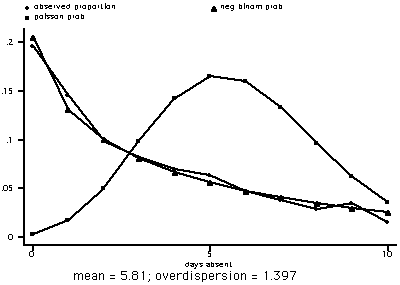

Analysis of count data, while not new, has seen a tremendous increase in interest in the last 20 years. Along with this increase in interest there have been numerous improvements in the technology for analyzing these types of data. In this section we will cover poisson models and negative binomial models for analyzing count data.
Poisson Models
Poisson probabilities are use to model the number of occurrences (counts) of an event. One of the early recorded uses of the Poisson distribution was the 1898 study investigating the number of Prussian soldiers that were kicked to death by horses.
Here is the poisson distribution function,

Table 1
y lambda = 1 lambda = 3 lambda = 5
0 0.36787945 0.04978707 0.00673795
1 0.36787945 0.14936121 0.03368973
2 0.18393973 0.22404180 0.08422434
3 0.06131324 0.22404180 0.14037390
4 0.01532831 0.16803135 0.17546737
5 0.00306566 0.10081881 0.17546737
6 0.00051094 0.05040941 0.14622281
7 0.00007299 0.02160403 0.10444486
8 0.00000912 0.00810151 0.06527804
9 0.00000101 0.00270050 0.03626558
10 0.00000010 0.00081015 0.01813279

As lambda increases, the distribution shifts to the right. For large values of lambda the
distribution is approximately normal.Distribution in which the mean equals the variance have equidispersion. When the variance is greater than the mean there is overdispersion. In practice, it is rare to find distributions with equidispersion.
The poisson regression model can be estimated using maximum-likelihood, with the following likelihood funxtion and log-likelihood function.




Poisson Regression Example
We will illustrate poisson regression using the lahigh data set. In particular, we would like to know whether there is a gender difference in days absent and the relation between language NCE test scores and days absent. Note that for gender, 0 is female and 1 is male. Here is a histogram of days absent.

use http://www.gseis.ucla.edu/courses/data/lahigh
summarize gender langnce daysabs
Variable | Obs Mean Std. Dev. Min Max
-------------+-----------------------------------------------------
gender | 316 .4873418 .5006325 0 1
langnce | 316 50.06379 17.93921 1.007114 98.99289
daysabs | 316 5.810127 7.449003 0 45
summarize daysabs, detail
days absent
-------------------------------------------------------------
Percentiles Smallest
1% 0 0
5% 0 0
10% 0 0 Obs 316
25% 1 0 Sum of Wgt. 316
50% 3 Mean 5.810127
Largest Std. Dev. 7.449003
75% 8 35
90% 14 35 Variance 55.48764
95% 23 41 Skewness 2.250587
99% 35 45 Kurtosis 8.949302
poisson daysabs gender langnce
Poisson regression Number of obs = 316
LR chi2(2) = 171.50
Prob > chi2 = 0.0000
Log likelihood = -1549.8567 Pseudo R2 = 0.0524
------------------------------------------------------------------------------
daysabs | Coef. Std. Err. z P>|z| [95% Conf. Interval]
-------------+----------------------------------------------------------------
gender | -.4093528 .0482192 -8.49 0.000 -.5038606 -.3148449
langnce | -.01467 .0012934 -11.34 0.000 -.0172051 -.0121349
_cons | 2.646977 .0697764 37.94 0.000 2.510217 2.783736
------------------------------------------------------------------------------
poisson, irr
Poisson regression Number of obs = 316
LR chi2(2) = 171.50
Prob > chi2 = 0.0000
Log likelihood = -1549.8567 Pseudo R2 = 0.0524
------------------------------------------------------------------------------
daysabs | IRR Std. Err. z P>|z| [95% Conf. Interval]
-------------+----------------------------------------------------------------
gender | .6640799 .0320214 -8.49 0.000 .6041936 .7299021
langnce | .9854371 .0012746 -11.34 0.000 .982942 .9879384
------------------------------------------------------------------------------
listcoef /* downloaded from Stata over the Internet */
poisson (N=316): Factor Change in Expected Count
Observed SD: 7.4490028
------------------------------------------------------------------
daysabs | b z P>|z| e^b e^bStdX SDofX
---------+--------------------------------------------------------
gender | -0.40935 -8.489 0.000 0.6641 0.8147 0.5006
langnce | -0.01467 -11.342 0.000 0.9854 0.7686 17.9392
------------------------------------------------------------------
listcoef, percent
poisson (N=316): Percentage Change in Expected Count
Observed SD: 7.4490028
----------------------------------------------------------------------
daysabs | b z P>|z| % %StdX SDofX
-------------+--------------------------------------------------------
gender | -0.40935 -8.489 0.000 -33.6 -18.5 0.5006
langnce | -0.01467 -11.342 0.000 -1.5 -23.1 17.9392
----------------------------------------------------------------------
InterpretationFrom the incidence rate ratios, being male decreases the expected number of days absent by a factor of .66, or equivalently, it decreases the expected number by 100*(.66-1)% = -33%. And, for each point increase in the language normal curve equivalence the expected number of days absent decreses by a factor of .98 (or 100*(.98-1)% = -2%) when the other variables are held constant.
The listcoef command also provides for standardized factor change. For a one standard deviation increase (approximately 18 points) in the language nce the expected number of days absent would decrease by a factor of .77 (100*(.77-1)% = -23%) with the other variables in the model held constant.
Another way of interpreting the model is to look at the marginal effects, also known as, partial change in the expected value.
mfx compute, at(mean)
Marginal effects after poisson
y = predicted number of events (predict)
= 5.5458276
------------------------------------------------------------------------------
variable | dy/dx Std. Err. z P>|z| [ 95% C.I. ] X
---------+--------------------------------------------------------------------
gender*| -2.274269 .26514 -8.58 0.000 -2.79393 -1.7546 .487342
langnce | -.0813573 .00695 -11.70 0.000 -.094982 -.067733 50.0638
------------------------------------------------------------------------------
(*) dy/dx is for discrete change of dummy variable from 0 to 1
mfx compute, at(mean langnce=60)
Marginal effects after poisson
y = predicted number of events (predict)
= 4.7936
------------------------------------------------------------------------------
variable | dy/dx Std. Err. z P>|z| [ 95% C.I. ] X
---------+--------------------------------------------------------------------
gender*| -1.96579 .22735 -8.65 0.000 -2.41139 -1.5202 .487342
langnce | -.0703221 .00515 -13.67 0.000 -.080408 -.060236 60.0000
------------------------------------------------------------------------------
(*) dy/dx is for discrete change of dummy variable from 0 to 1
Finally, we will look at the poisson goodness of fit. We should have looked at it earlier before
trying to interpret the model but we needed to take some time to discuss how one goes about
interpreting a poisson model.
poisgof
Goodness-of-fit chi2 = 2238.317
Prob > chi2(313) = 0.0000
The large chi-square suggest that there is not a very good fit for the poisson regression
model. This could either be because the explanatory variables are not very good or
the poisson model is not appropriate. We saw earlier that the variance for daysabs was much
greater than the the mean. This suggest that there is overdispersion. We will use nbvargr to compare
the fit for poisson versus negabitive binomial models.
nbvargr daysabs /* downloaded over the Internet */
Obtaining Parameter Estimates
(23 observations deleted)
Negative Binomial Probabilities
with mean = 5.810127 & overdispersion = 1.397268
k nbprob nbcum
1. 0 0.20559212 0.20559211
2. 1 0.13100202 0.33659413
3. 2 0.10005438 0.43664852
4. 3 0.08063899 0.51728749
5. 4 0.06669218 0.58397967
6. 5 0.05600163 0.63998133
7. 6 0.04749728 0.68747860
8. 7 0.04057066 0.72804928
9. 8 0.03483756 0.76288682
10. 9 0.03003709 0.79292393
11. 10 0.02598259 0.81890649
Poisson Probabilities for lambda = 5.810127
k pprob pcum
1. 0 0.00299705 0.00299705
2. 1 0.01741324 0.02041029
3. 2 0.05058656 0.07099685
4. 3 0.09797145 0.16896829
5. 4 0.14230664 0.31127495
6. 5 0.16536394 0.47663888
7. 6 0.16013090 0.63676977
8. 7 0.13291156 0.76968133
9. 8 0.09652913 0.86621046
10. 9 0.06231628 0.92852676
11. 10 0.03620655 0.96473330

As we suspected, the poisson model did not do a good job of approximating daysabs.
The fact is overdispersion is very common in "real" data, the poisson distribution which works well
in theory does not perform all that well in practice.
The negative binomial model looks to be a much better fit.
Categorical Data Analysis Course
Phil Ender